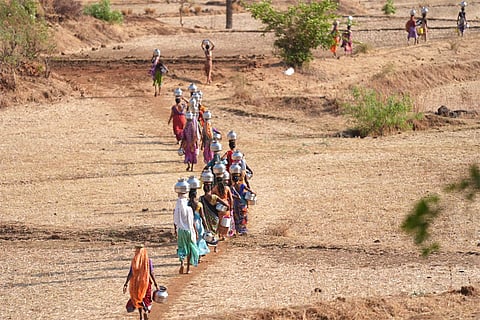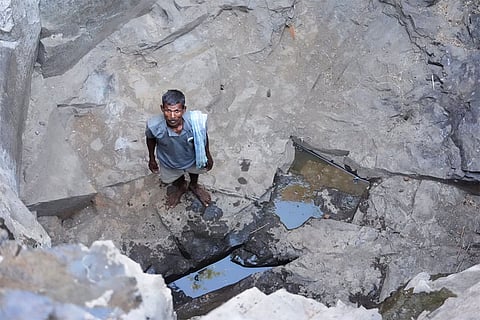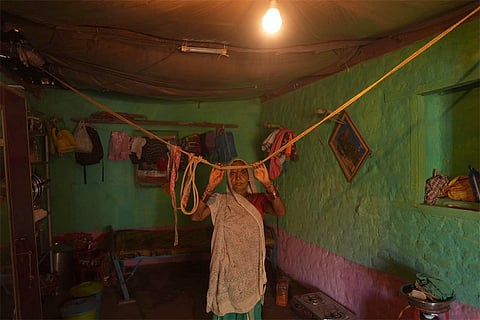After a video by ANI showing women climbing down the well of borchvari village went viral, the sarpanch announced the sale of 200-liter water barrels at ₹60. But most families cannot afford even that. And so, their treacherous journey to other villages for water continues.
Water Woes In Borchibari: Another Struggling Village In Maharashtra, Gripped By Summer, Where The State바카라 웹사이트Remains바카라 웹사이트Absent
Borchibari, a small village on the Maharashtra Gujarat border, is one of six settlements in Nashik라이브 바카라 Peth Taluka struggling with a severe water crisis. Despite receiving heavy monsoon rains, the village runs dry by January every year. Its three wells can’t retain water, forcing residents, mostly women, to walk over two kilometers daily to fetch water from a neighboring village. The situation gained attention after a viral video showed women climbing into deep, unsafe wells to collect contaminated water. While this prompted a token response from local authorities, such as dumping water into one well, sustainable solutions remain missing. Painted walls bearing the logo of the Jal Jeevan Mission are now fading symbols of inaction. Though the mission promised tap water for all rural homes, no real implementation has occurred in Borchivari. Pipelines were laid multiple times but no water ever arrived. A private tanker system exists, but the cost, ₹60 for 200 litres, is beyond reach for most families. Several earlier interventions, including efforts by local leaders and NGOs, failed due to lack of continuity and planning. Meanwhile, rainfall continues to flood homes but cannot be harvested effectively due to poor infrastructure. Despite Maharashtra being declared a top performing state under the Jal Jeevan Mission in 2023, villages like Borchibari expose the disconnect between data and reality.

At 4 p.m., as the sun still hangs high in the sky, women step out with empty barrels, pots, and buckets. They walk two kilometers to Kumbhale, where a well with a slightly better water table is located—though it, too, is rapidly depleting.

On their way back, Savita Busare often passes the government tank built five years ago. It has never functioned properly—its structure leaking from the start. This, despite Borchiwari receiving maximum rainfall during June and July. From January to May, however, the villagers must carry empty barrels.

There라이브 바카라 a clear demarcation now: for drinking water, women walk to Kumbhale; for washing clothes, they go to the pond in Mohachapada. The sarpanch is from Mohachapada, and there have been past skirmishes between the two villages over water access.

He found water only in the crevices of stone. Yet, he filled the bucket—not for his own family, but for the neighbors who live nearby. “They need it more than us,” he said.

In Borchibari village, Peith Taluka, Nashik district, only one out of the three wells is shallow enough for women to climb down. That day, Kashinath Gavit, 55, descended into the well instead of his wife, who had gone to another village to wash clothes at the pond.

Yashodha Busare walks two kilometers daily to fetch three pots of water. But the task doesn’t end there. She must filter it twice using a cloth to remove the tiny pebbles.

Bharti Gavit, originally from Gujarat, got married into this village 18 years ago. She had no idea about the acute water scarcity in Borchiwari. Her husband is often away, driving a truck. Still, she ensures their 16-year-old son never goes to college with an empty water bottle.

'We eat more chapati than rice because rice makes you feel thirsty.' Barchi Nakule says

Water Woes of Borchibari village in Nashik district, The village might appear to be suffering from an acute water shortage, but the families have adapted to the meagre response by the panchayat. "Khud ka ugate hain, khud ka khate hain," said Barchi Nikule. They own a small plot of land where they sow onions and wheat. Though the land is barren for now, it will flourish with the advent of the monsoon.

Borchibari is an Adivasi village where almost every family owns cattle. The cattle, like their owners, drink water once every 24 hours. The scorching heat has left fields barren, so in many houses food is prepared just once a day to conserve water.

Electricity is not an issue, every house has a bulb but paying the bill is. Shanabai Gavit wears a murky expression as she explains how even a ₹200 bill is unaffordable. With the heat forcing many into unemployment, even those who go to Nashik as laborers struggle.

Most villagers build their own houses, cutting teak trees from the nearby forests. These are loaded onto trucks in bulk and sold to merchants for manufacturing. The village falls under Maharashtra Van Vibhag and is part of the West Nashik Forest Circle.